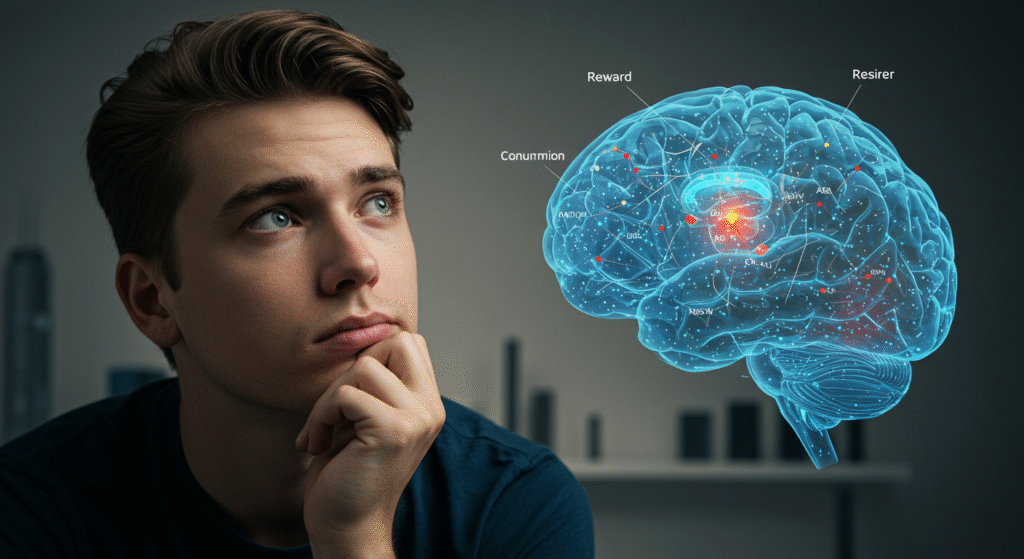Spending money on things we don’t really need is something most of us have done at one point or another. It feels good in the moment, but often leaves us wondering why we made that purchase later. Understanding the psychology of spending helps explain why these impulses happen and what drives us to buy beyond necessity.
Our choices aren’t purely logical. Emotions like stress, boredom, or the need to fit in play a big role in pushing us toward those extra purchases. Marketers and social influences also tap into these feelings, making it harder to resist. By exploring the mental triggers behind our buying habits, we can start to recognize patterns and gain control over our spending.
This article will break down the reasons behind why we buy what we don’t need and share practical tips to help stop the cycle. By knowing the real forces behind our spending, the path to smarter, more intentional decisions becomes clearer.
The Brain’s Reward System and Spending Habits

Understanding why we reach for something we don’t really need boils down to how our brain reacts to rewards. Spending activates parts of the brain that signal pleasure and motivation, encouraging repeated behavior even if it’s not logical. This section will explain how the brain’s chemical messengers influence buying, and how emotions often push us to make impulse purchases.
Dopamine: The Feel-Good Chemical Behind Purchases
Dopamine plays a key role in why spending feels good, yet often only temporarily. When you browse, click “add to cart,” or swipe your credit card, your brain releases dopamine. This neurotransmitter acts like a reward signal, making you feel pleasure and excitement.
This chemical surge motivates us to chase that feeling again. It explains why some purchases feel like a hit of happiness even if the item isn’t necessary. After the dopamine rush fades, the urge to buy more often returns, keeping the cycle going.
The dopamine release happens not only when you get the product but also when you anticipate the purchase, which is why window shopping and browsing online sales can feel rewarding too. This system evolved to reward helpful actions, like finding food or social bonding, but modern consumerism taps into it, making buying addictive for some.
Impulse Buying and Emotional Triggers
Impulse purchases rarely happen in a purely rational state. Instead, emotions serve as strong triggers that push us to buy without much thought.
Common emotional states fueling impulse buying include:
- Stress: Buying can act like a quick mood lift or distraction from pressure.
- Boredom: Shopping fills time and gives a sense of novelty or excitement.
- Happiness: Celebratory moods can encourage treating ourselves to something extra.
When emotions run high, our brain’s decision-making shifts from the logical prefrontal cortex to more impulsive areas. This shift makes resisting temptation harder as feelings override analysis. Stores and websites design their environments to play on these emotional states using bright colors, catchy music, and limited-time offers to spur quick decisions.
Recognizing these emotional triggers is vital if you want to avoid spending beyond your needs. When you catch yourself reaching for your wallet, pause and reflect on what feeling you’re trying to satisfy. Most times, your brain isn’t looking for the product itself, just the emotional payoff attached to getting it.
Social Influences and Marketing Tactics That Fuel Unnecessary Spending

When we look closely at why we buy things we don’t need, social influences and marketing tactics play a huge role. Our spending behavior doesn’t happen in a vacuum our surroundings, especially online, and the messages marketers send to us are carefully designed to push us toward spending beyond necessity. Understanding these forces helps us catch the triggers before they take control of our wallets.
How Social Media Shapes Spending Behavior
Social media presents us with highly curated versions of life, often polished and perfect-looking snapshots carefully chosen to impress. Seeing friends, celebrities, or influencers flaunt their latest gadgets, clothes, or experiences creates a subtle but powerful pressure to keep up. This effect is largely driven by FOMO, or Fear of Missing Out, which makes us feel like we must take part in trends to avoid being left behind.
This pressure often leads to spending that isn’t planned or needed:
- Influencer content frequently showcases new products in everyday life, making us associate those items with happiness or success.
- Peer spending, or seeing others’ purchases, triggers social comparison. Even if it’s something you don’t want, the desire to match or exceed what others have kicks in.
- High engagement on platforms like Instagram and TikTok means constant exposure to these lifestyles, reinforcing spending habits that surpass our real needs.
This cycle of exposure and comparison can cause lifestyle inflation where we start spending more just because we see others doing it—even if it means straining our finances.
Marketing Strategies That Tap into Our Psychology
Marketers know exactly how to tap into our emotions and decision-making tendencies. Their strategies are built around the way our brain processes urgency, social proof, and personalization:
- Limited-time offers create a sense of urgency, pushing you to buy now or miss out. This taps into loss aversion—the fear of losing a good deal—which overrides logical thinking.
- Personalized recommendations make products appear specially chosen for you, increasing the chance you’ll feel a personal connection and go ahead with the purchase.
- Persuasive advertising uses emotional storytelling, attractive visuals, and catchy slogans to make products more appealing. It often links products to positive feelings or aspirational identities.
These tactics work because they don’t just advertise a product; they play with feelings like excitement, belonging, and fear. The result is many purchases driven by emotion rather than practical need.
Recognizing when marketers are using these techniques can give you the upper hand. When you see a “limited-time” deal or a product popping up with your name on it, it helps to pause and ask whether this purchase fits your actual priorities or if it’s just a clever nudge.
Combining social influence with smart marketing creates a perfect storm one that makes unnecessary spending almost feel natural until you step back and look at the bigger picture.
Practical Strategies to Control Unnecessary Spending

Controlling unnecessary spending isn’t about depriving yourself; it’s about making smarter choices that respect both your needs and your goals. I’ve found that practical habits can build a solid foundation to stop impulse buys and regain control over finances. Here are some effective approaches you can start using immediately.
The 24-Hour Rule and Budgeting Techniques
One simple but powerful method I use to stop impulsive purchases is the 24-hour rule. When tempted by a non-essential item, I pause and wait a full day before buying. This break often cools down the emotional urge, gives me time to consider if I really need it, and prevents buyer’s remorse. Most of the time, I realize the item isn’t worth it or find a better use for my money.
Coupled with this, creating a budget acts like a roadmap for spending. A popular budgeting method is the 50/30/20 rule, which breaks your after-tax income into:
- 50% for necessities (rent, groceries)
- 30% for wants (entertainment, dining out)
- 20% for savings and debt repayment
This clear division helps keep wants in check while encouraging saving. Having a budget also highlights areas of overspending you might not notice, letting you adjust habits before problems grow. Over time, these frameworks become habits that naturally reduce wasteful spending.
Mindfulness and Spending Awareness
Spending without thinking is easy, especially when emotions get involved. Practicing mindfulness means becoming aware of what triggers those spending urges. Personally, I ask myself if I’m shopping due to boredom, stress, or just habit. This little pause often reveals that I’m trying to fill an emotional gap, not actually making a practical purchase.
One effective way to stay conscious of spending is shifting from cards to cash payments. When you hand over physical cash, spending feels more “real.” This creates an instant emotional connection to the money leaving your hands and makes it harder to spend recklessly. I often set cash aside for discretionary spending, which keeps me more aware of what I’m actually using and prevents overspending.
Reducing Social Media Influence and Advertising Exposure

Social media and online ads are designed to influence us they constantly show peer lifestyles and products that trigger FOMO or the desire to keep up. Cutting down on time spent scrolling can seriously reduce these pressures. I find setting app limits or taking regular breaks helps break the cycle of constant exposure.
Also, consider using ad blockers or unsubscribing from promotional emails. This doesn’t just reduce distractions but also lowers the chance of impulse purchases triggered by targeted ads or flash sales.
By limiting these external influences, you give yourself space to focus on what truly matters. Spending then becomes a choice based on your goals, not a reaction to social pressure or marketing tricks.
Controlling unnecessary spending is less about restricting yourself harshly and more about creating moments of reflection, intentionality, and awareness. Using practical rules like the 24-hour wait, mindful habits around money, and reducing external triggers puts you in charge of your financial decisions. This way, you spend with purpose rather than habit.
Conclusion
The psychology of spending reveals how deeply emotions, brain chemistry, and social pressures influence why we buy things we don’t need. Recognizing the role of dopamine and impulse triggers shows that many purchases come from a search for short-term satisfaction rather than true necessity.
Understanding these forces empowers us to break the cycle. By applying simple strategies like pausing before buying and reducing exposure to marketing, we can make clearer, more intentional choices. This awareness reshapes not only how we spend but how we value what we own.
With mindful habits and a fresh perspective, controlling unnecessary spending becomes achievable. Taking charge of your financial decisions starts with knowing the reasons behind them, and from there, you can build habits that protect your wallet and your peace of mind.




